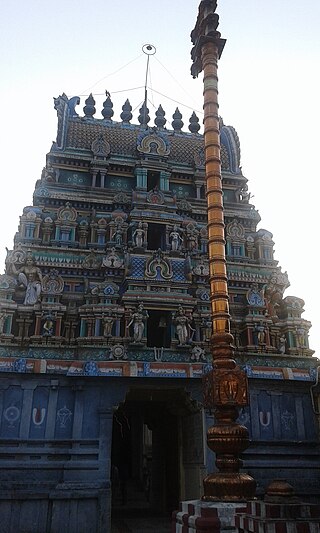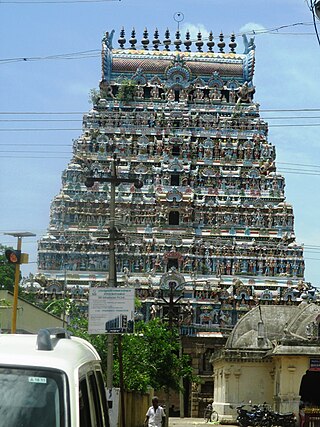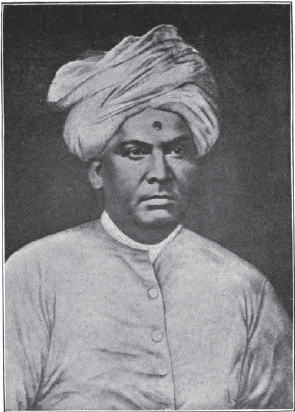
Tamil literature includes a collection of literary works that have come from a tradition spanning more than two thousand years. The oldest extant works show signs of maturity indicating an even longer period of evolution. Contributors to the Tamil literature are mainly from Tamil people from south India, including the land now comprising Tamil Nadu, Kerala, Eelam Tamils from Sri Lanka, as well as the Tamil diaspora.

Kumari Kandam is a mythical continent, believed to be lost with an ancient Tamil civilization, supposedly located south of present-day India in the Indian Ocean. Alternative names and spellings include Kumarikkandam and Kumari Nadu.

Kannadasan was an Indian philosopher, poet, film song lyricist, producer, actor, script-writer, editor, philanthropist, and is heralded as one of the greatest and most important lyricists in India. Frequently called Kaviarasu, With over 5000 lyrics, 6000 poems and 232 books, Kannadasan is widely known by the sobriquet Kaviarasu and he is also considered to be the greatest modern Tamil poet after Subramania Bharati. including novels, epics, plays, essays, his most popular being the 10-part religious book on Hinduism, Arthamulla Indhu Matham. He won the Sahitya Akademi Award for his novel Cheraman Kathali in the year 1980 and was the first to receive the National Film Award for Best Lyrics, given in 1969 for the film Kuzhanthaikkaga. Like many great poets he also suffered from cyclothymia, which comes under bipolar disorder spectrum.

Chola Nadu is a cultural region of the Tamil Nadu state in southern India. It encompasses the lower reaches of the Kaveri River and its delta, and formed the cultural homeland and political base of the Chola Dynasty which ruled large parts of South India and parts of Sri Lanka between the 9th and 13th centuries CE. Uraiyur served as the early Chola capital, then medieval Cholas shifted to Thanjavur and later cholas king Rajendra Chola I moved the capital to Gangaikonda Cholapuram in Ariyalur in the 11th century CE.

Rashtrakuta was a Hindu dynasty ruling large parts of the Indian subcontinent between the 6th and 10th centuries. The earliest known Rashtrakuta inscription is a 7th-century copper plate grant detailing their rule from Manapur, a city in Central or West India. Other ruling Rashtrakuta clans from the same period mentioned in inscriptions were the kings of Achalapur and the rulers of Kannauj. Several controversies exist regarding the origin of these early Rashtrakutas, their native homeland and their language.

Harikatha, also known as Harikatha Kaalakshepam in Telugu and Tamil, is a form of Hindu traditional discourse in which the storyteller explores a traditional theme, usually the life of a saint or a story from an Indian epic. The person telling the story through songs, music and narration is called a Haridasa.

Koodal Aḻagar Temple in Madurai, a city in the South Indian state of Tamil Nadu, is dedicated to the Hindu god Vishnu. Constructed in the Dravidian style of architecture, the temple is glorified in the Naalayira Divya Prabandham, the early medieval Tamil canon of the Alvar saints from the 6th–9th centuries CE. It is one of the 108 Divya Desams dedicated to Vishnu, who is worshipped as Viyooga Sundarrajan, and his consort Lakshmi as Mathuravalli.
Kalyana Varadharaja Perumal Temple is a temple in Paruthiyur, Sengalipuram, Thiruvarur District, India. The temple is located on the banks of the Kudamurutti River, a distributary of the River Kaveri.

Rashtrakuta literature is the body of work created during the rule of the Rastrakutas of Manyakheta, a dynasty that ruled the southern and central parts of the Deccan, India between the 8th and 10th centuries. The period of their rule was an important time in the history of South Indian literature in general and Kannada literature in particular. This era was practically the end of classical Prakrit and Sanskrit writings when a whole wealth of topics were available to be written in Kannada. Some of Kannada's most famous poets graced the courts of the Rashtrakuta kings. Court poets and royalty created eminent works in Kannada and Sanskrit, that spanned such literary forms as prose, poetry, rhetoric, epics and grammar. Famous scholars even wrote on secular subjects such as mathematics. Rashtrakuta inscriptions were also written in expressive and poetic Kannada and Sanskrit, rather than plain documentary prose.
Katha is an Indian style of religious storytelling, performances of which are a ritual event in Hinduism. It often involves priest-narrators who recite stories from Hindu religious texts, such as the Puranas, the Ramayana or Bhagavata Purana, followed by a commentary (Pravachan). Kathas sometimes take place in households, involving smaller stories related to the Vrat Katha genre. The didactic Satyanarayan and Ramayana kathas instill moral values by revealing the consequences of human action (karma).

The Devaadi Raja Perumal temple in Therazhundur, a village in Mayiladuthurai district of the South Indian state of Tamil Nadu, is dedicated to the Hindu god Vishnu. Constructed in the Dravidian style of architecture, the temple is glorified in the Naalayira Divya Prabandham, the early medieval Tamil canon of the Alvar saints from the 6th–9th centuries CE. It is one of the 108 Divya Desams dedicated to Vishnu, who is worshipped as Amaruviappan, and his consort Lakshmi as Sengamalavalli Thayar. The original structure of the temple was built by the Karikala Chola during the 1st century CE, with later additions from the Cholas during the 11th century.
Medieval Kannada literature covered a wide range of subjects and genres which can broadly be classified under the Jain, Virashaiva, Vaishnava and secular traditions. These include writings from the 7th century rise of the Badami Chalukya empire to the 16th century, coinciding with the decline of Vijayanagara Empire. The earliest known literary works until about the 12th century CE were mostly authored by the Jainas along with a few works by Virashaivas and Brahmins and hence this period is called the age of Jain literature,. The 13th century CE, to the 15th century CE, saw the emergence of numerous Virashaiva and Brahminical writers with a proportional decline in Jain literary works. Thereafter, Virashaiva and Brahmin writers have dominated the Kannada literary tradition. Some of the earliest metres used by Jain writers prior to 9th century include the chattana, bedande and the melvadu metres, writings in which have not been discovered but are known from references made to them in later centuries. Popular metres from the 9th century onwards when Kannada literature is available are the champu-kavyas or just champu, vachanasangatya, shatpadi, ragale, tripadi, and kavya.
Raja Mannargudi Mahamahopadhyaya Thyagaraja Mahi Raju Sastrigal, also known as Mannargudi Raju Sastri or Mannargudi Periyaval, was a Hindu scholar. He was born in the Bharadwaja Vamsa, as a descendant of Adayappaalam Sri Appayya Dikshitar. Raju Sastri was born in the village of Kuthambadi in today's Thiruvarur district as son of Maragathavalli Janakiammal and Sri Markasahaya Appa Dikshitar
The Vishahareswara Temple is a temple to Shiva in the Thiruvarur district of Tamil Nadu, India. The temple was built in the early 9th century in the village of Kodandaramapuram, which later became part of Avanam Paruthiyur, situated on the banks of the Kudamurutti River, a distributary of the Kaveri. The presiding deity of this temple is a form of Shiva called Vishahareswarar, and his consort Prasanna Parvathy Devi. The temple today is an ancient heritage symbol of the village. The temple was one of the 108 Shiva temples built by Cholan Aditya Varman 1, on the banks of the Kaveri.
V.T. Subramania Pillai aka V.T.S. was a scholar of Tamil music in India. He published books containing more than 1,100 songs of Thirupugal.

Mahalingeswaraswamy Temple, Thiruvidaimarudur is a Hindu temple dedicated to the deity Shiva, located in Tiruvidaimaruthur, a village in the South Indian state of Tamil Nadu. It is significant to the Hindu sect of Saivism as one of the seven major Shiva temples. Shiva is worshiped as Mahalingeswaraswamy, and is represented by the lingam, with his idol referred to as Jyothirmayalingam. His consort Mookambika is depicted as Devi Bruhatsundarakuchaambika or Bruhatsundarakuchaambigai amman. The lingam of the temple is believed to be the focal point for the seven consorts of Shiva. The presiding deity is revered in the 7th century Tamil Saiva canonical work, the Tevaram, written by Tamil poet saints known as the nayanars and classified as Paadal Petra Sthalam. The 9th century Saiva saint poet Manikkavacakar has sung praise about the temple in his works. Pattinattar, one of the revered saints visited this shrine many times.

Siva Prakasar was a Tamil poet and philosopher who lived during the late 17th and early 18th centuries. He was also called "Thurai mangalam Sivaprakasar", "Karpanai Kalangiyam", and "Sivanuputhi chelvar". He contributed more than 34 Tamil books, the most well-known of which is the Nanneri, a work dealing with moral instruction. He is also well known for translating early Kannada works into Tamil, and for creating his own poetry.

The Makara Nedunkuḻaikathar Temple is one of the Nava Tirupathi, nine Hindu temples dedicated to Vishnu located Thenthiruperai along Tiruchendur-Tirunelveli route, Tamil Nadu, India in the southern bank of Thamiraparani river. It is located 5 km from Alvar Thirunagari All these 9 temples are classified as Divya Desams, the 108 temples of Vishnu revered by the 12 poet saints, or Alvars. The temple is referred to as Sukra sthalam, a location for the planet deity, Sukra. Constructed in the Dravidian style of architecture, the temple is glorified in the Nalayira Divya Prabandham, the early medieval Tamil canon of the Alvar saints from the 6th–9th centuries CE. It is one of the 108 Divya Desams dedicated to Vishnu, who is worshipped as Makara Nedunkuḻaikathar and his consort Lakshmi as Tiruperai Nachiyar.

Vaithamanidhi Permual Temple is one of the nine Nava Tirupathi, the Hindu temples dedicated to Vishnu. It is located on the Tiruchendur–Tirunelveli route in Tamil Nadu, India, on the southern bank of the Thamiraparani River, 4 km from Alwarthirunagari. It is the eighth temple of Nava Tirupathi, and is named after Mars (Sevvai) and also called Kuberasthalam. Constructed in the Dravidian style of architecture, the temple is glorified in the Nalayira Divya Prabandham, the early medieval Tamil canon of the Alvar saints from the 6th–9th centuries CE. It is one of the 108 Divya Desams dedicated to Vishnu, who is worshipped as Vaithamanidhi Perumal and his consort Lakshmi as Kolurvalli.

The Calamur Viravalli family, inclusive of closely intermarried "merged" lines was one of the two preeminent Brahmin dynasties in the Madras Presidency who dominated the Mylapore clique, alongside the Vembaukum family. They were originally Vadama Iyers from Kalambur and nearby hamlets in North Arcot, who traced their ancestry to Appayya Dikshita, and before that, Deshastha movements from the North. They were traditionally by hereditary profession renowned Sanskritists, as with Anantharama, father of patriarch C. V. Runganada Sastri, Anantharama's father, and Anantharama's father's father, but rapidly adapted to the practice and administration of law and English-style governance, with many Calamurs coming to rank among India's most celebrated lawyers, jurists, administrators, and statesmen.













